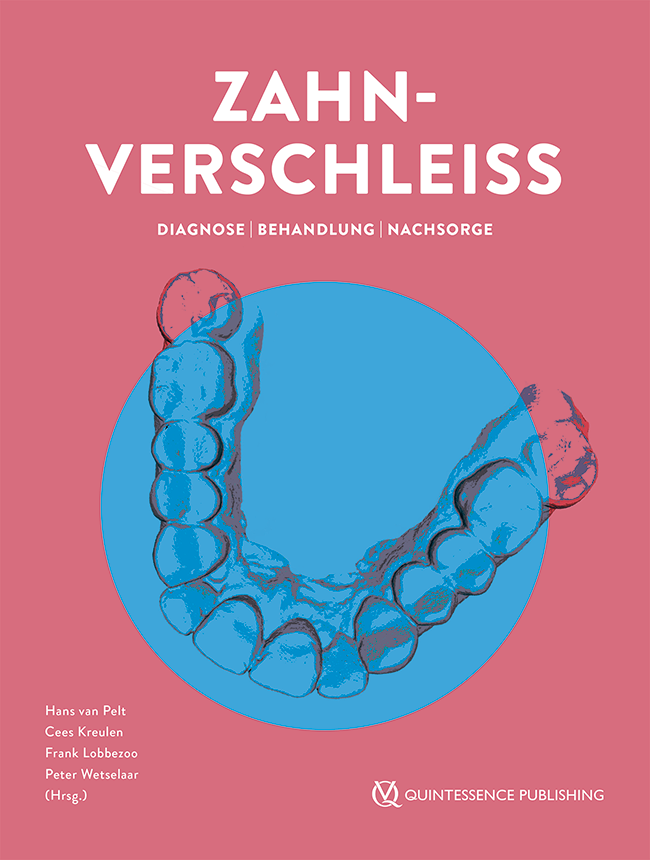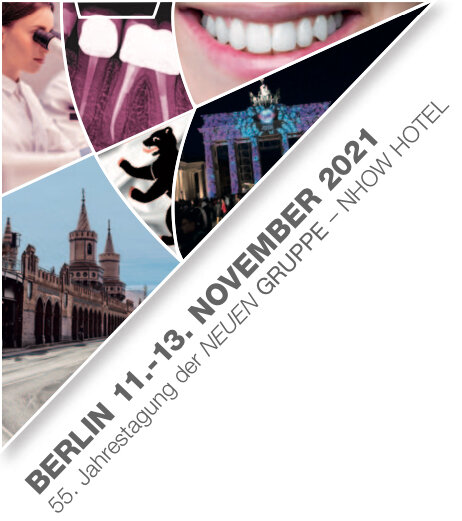Quintessenz Zahnmedizin, 5/2022
Zahnheilkunde interdisziplinärPáginas 456-468, Idioma: AlemánAhlers, M. Oliver / Wetselaar, PeterWährend die Kariesinzidenz erfreulicherweise zurückgeht, steigt die des Zahnverschleißes. Im Sinne einer präventionsorientierten Zahnheilkunde ist es wichtig, die Betroffenen früh zu erkennen, die individuellen Ursachen zu identifizieren und möglichst abzustellen. Von die hierfür vorgeschlagenen Befundschemata sieht nur das „Tooth wear evaluation system“ (TWES) 2.0 eine mehrstufige Untersuchung vor. Es beruht auf einer Basisdiagnostik in Form des Zahnverschleiß-Screenings zur Identifikation auffälliger Patienten. Bei diesen wird als erweiterte Diagnostik ein detaillierter Zahnverschleiß-Status erhoben – mit quantitativer Erfassung der Verschleißgrade aller Zähne pro Zahn. Ergänzt wird sie durch eine qualitative Suche nach Zeichen pathologischen Zahnverschleißes sowie von Hinweisen auf die Verschleißursache. Der nachfolgende Beitrag beschreibt die stufenweise Diagnostik und ihre Umsetzung in der digitalen Praxis.
Manuskripteingang: 25.03.2022, Manuskriptannahme: 26.03.2022
Palabras clave: Zahnverschleiß, Zahnverschleiß-Screening, Zahnverschleiß-Status, „Tooth wear evaluation system“ (TWES) 2.0, Bruxismus, Erosionen
Oral Health and Preventive Dentistry, 1/2021
Acceso libre Sólo en líneaOral MedicineDOI: 10.3290/j.ohpd.b1694095, ID de PubMed (PMID): 3425942715. jul 2021,Páginas 345-351, Idioma: InglésKrol, Giulia L.S. / Wetselaar, Peter / Attin, Thomas / Papagianni, Chryssa E. / Wegehaupt, Florian J.Purpose: To determine the impact of the brushing protocol on dentin wear by comparing continuous to intermittent brushing, with the same total time of brushing.
Materials and Methods: Dentin specimens (n = 120) were evently distributed into six groups (A–F). The samples were brushed with slurries of different relative dentin abrasivity (RDA): Groups A+B (Sident 2480-1; RDA 85), groups C+D (Zeodent 113; RDA 67), and groups E+F (Zeodent 103; RDA 174). Groups A+C+E were brushed continuously (25 min) with one slurry preparation, while groups B+D+F were brushed intermittently (25 x 1 min) with a renewal of the slurry after each sequence. Dentin wear was determined using surface profilometry and statistically analysed with ANOVA and post-hoc tests.
Results: Neither the mode of brushing (p = 0.72) nor the interaction (p = 0.18) of the brushing mode with the type of abrasive particles had a significant influence on the abrasive dentin wear. Only the type of abrasive particles had a statistically significant influence on abrasive dentin wear (p < 0.001).
Conclusion: The mode of brushing (continuously or intermittently) has no influence on abrasive dentin wear.
Palabras clave: brushing, continuously, dentin wear, intermittently
Journal of Craniomandibular Function, 3/2020
Páginas 253-272, Idioma: Alemán, InglésAhlers, M. Oliver / Wetselaar, PeterWährend durch die gute Prävention die Karies zurückgeht, nimmt die Inzidenz von Zahnverschleiß zu – besonders bei jungen Erwachsenen. Zur Identifikation der Betroffenen sind in der Vergangenheit verschiedene Befundschemata vorgeschlagen worden. Davon sah nur das Tooth Wear Evaluation System (TWES) eine mehrstufige Untersuchung aus Basisdiagnostik und erweiterter Diagnostik vor. Hierzu wurde jüngst eine Aktualisierung veröffentlicht, das TWES 2.0. Dies soll zunächst mit einem Zahnverschleiß- Screening auffällige Patienten identifizieren. Anschließend wird bei diesen Patienten ein detaillierter Zahnverschleiß-Status erhoben. Dieser erfasst die Verschleißgrade jedes einzelnen Zahns, Anzeichen pathologischen Zahnverschleißes sowie Hinweise auf die Verschleißursache. Der Beitrag schildert das praktische Vorgehen bei digitaler Erfassung und Auswertung der Befunde mittels spezieller Software (CMDbrux) sowie die darauf basierte Behandlung anhand eines Patientenfalls.
Palabras clave: Zahnverschleiß, Zahnverschleiß-Screening, Zahnverschleiß-Status, Tooth Wear Evaluation System (TWES 2.0), Bruxismus, CMDbrux, minimalinvasive Restauration
Journal of Craniomandibular Function, 2/2020
Páginas 133-143, Idioma: Alemán, InglésWetselaar, PeterDieser Artikel erläutert, wie sich das Zahnverschleißbewertungssystem (Tooth Wear Evaluation System, TWES) für eine strukturierte Diagnostik bestehenden Zahnverschleißes verwenden lässt. Seit seiner Einführung ist das TWES bei vielen Zahnärzten in verschiedenen Ländern im Einsatz. Die gesammelten Rückmeldungen wurden von den Entwicklern und von Nutzern analysiert, woraus eine angepasste Fassung hervorgegangen ist: das TWES 2.0. Die Anpassungen und die neu eingeführte Taxonomie führen zu einem reibungsloseren Einsatz in der täglichen Praxis, einem geradlinigeren Diagnosesystem und einer strukturierten Behandlung.
Palabras clave: Zahnverschleiß, Zahnverschleißbewertungssystem, Europäische Konsensuserklärung, Klassifikation, Diagnose, Behandlung, pathologischer Zahnverschleiß, physiologischer Zahnverschleiß, Taxonomie
Quintessenz Zahnmedizin, 3/2018
ProthetikPáginas 270-283, Idioma: AlemánLoomans, Bas / Opdam, Niek / Attin, Thomas / Bartlett, David / Edelhoff, Daniel / Frankenberger, Roland / Benic, Goran / Ramseyer, Simon / Wetselaar, Peter / Sterenborg, Bernadette / Hickel, Reinhard / Pallesen, Ulla / Mehta, Shamir / Banerji, Subir / Lussi, Adrian / Wilson, NairnDer Beitrag fasst die europäische Konsensus-Leitlinie zur zahnärztlichen Therapie bei fortgeschrittenem Zahnhartsubstanzverlust zusammen. Er fokussiert auf die Definition von physiologischem versus pathologischem Zahnhartsubstanzverlust und empfiehlt, die Diagnostik, Prävention, Aufklärung und Überwachung auf die Ätiologie, die Art und das Ausmaß des pathologischen Zahnhartsubstanzverlustes sowie Mittel zu seiner Kontrolle auszurichten. Therapieentscheidungen werden von vielen Faktoren beeinflusst und sind sowohl vom Schweregrad und von den klinischen Auswirkungen des Zahnhartsubstanzverlustes als auch von den Wünschen des Patienten abhängig. Idealerweise werden restaurative Maßnahmen so lange wie möglich hinausgezögert. Wenn eine solche Intervention indiziert ist und der betroffene Patient zustimmt, wird ein konservierender minimalinvasiver Ansatz mit ergänzenden Präventionsmaßnahmen empfohlen. Beispielhaft werden adhäsive minimalinvasive Therapiekonzepte vorgestellt.
Palabras clave: Zahnhartsubstanzverlust, Entscheidungsfindung, restaurative Behandlung, direkte Restauration, indirekte Restauration
The Journal of Adhesive Dentistry, 2/2017
DOI: 10.3290/j.jad.a38102, ID de PubMed (PMID): 28439579Páginas 111-119, Idioma: InglésLoomans, Bas / Opdam, Niek / Attin, Thomas / Bartlett, David / Edelhoff, Daniel / Frankenberger, Roland / Benic, Goran / Ramseyer, Simon / Wetselaar, Peter / Sterenborg, Bernadette / Hickel, Reinhard / Pallesen, Ulla / Mehta, Shamir / Banerji, Subir / Lussi, Adrian / Wilson, NairnThis paper presents European expert consensus guidelines on the management of severe tooth wear. It focuses on the definition of physiological vs pathological tooth wear and recommends diagnosis, prevention, counseling, and monitoring aimed at elucidating the etiology, nature, rate and means of controlling pathological tooth wear. Management decisions are multifactorial, depending principally on the severity and effects of the wear and the wishes of the patient. Restorative intervention is typically best delayed as long as possible. When such intervention is indicated and agreed upon with the patient, a conservative, minimally invasive approach is recommended, complemented by supportive preventive measures. Examples of adhesive, minimum-intervention management protocols are presented.
Palabras clave: tooth wear, decision making, restorative treatment, direct, indirect
Journal of Craniomandibular Function, 1/2017
Páginas 27-38, Idioma: Inglés, AlemánWetselaar, Peter / Lobbezoo, FrankPart 2: treatment/management modules and discussionTooth wear is a multifactorial condition leading to the loss of dental hard tissue, ie, enamel and dentin. Tooth wear can be divided into the subtypes mechanical wear (attrition and abrasion), and chemical wear (erosion). Due to its multifactorial etiology, tooth wear can manifest in many different ways. The condition can therefore be difficult to diagnose and manage. A systematic approach is a sine qua non. In the Tooth Wear Evaluation System (TWES) described in this article (the second in a series of two), all the necessary tools for a clinical guideline are presented in various modules. This allows the clinician to perform a state-of-the-art diagnosis, in both a general practitioner and a referral setting. To avoid the risk of cumbersome usage, the clinician can select only those modules appropriate in a given setting. The modules of the TWES match each other, which is indispensable and essential when different modules are being compared. With the TWES it is possible to recognize the problem (qualification), grade its severity (quantification), diagnose the likely causes, and monitor (the progress of) the condition. In addition, a proposal for the classification of tooth wear is made. Further, it is possible to decide when to start a restorative treatment and which kind of treatment to apply, as well as to estimate the level of difficulty of the treatment. In this second article of the two-part series1, the management modules are described.
Palabras clave: clinical guideline, management planning, tooth wear
Journal of Craniomandibular Function, 4/2016
Acceso librePáginas 313-326, Idioma: Inglés, AlemánWetselaar, Peter / Lobbezoo, FrankPart 1: introduction, diagnostic modules, and classificationTooth wear is a multifactorial condition, leading to the loss of dental hard tissue, ie, enamel and dentin. Tooth wear can be divided into the subtypes mechanical wear (attrition and abrasion), and chemical wear (erosion). Due to its multifactorial etiology, tooth wear can manifest in many different ways. The condition can therefore be difficult to diagnose and manage. A systematic approach is a sine qua non. In the Tooth Wear Evaluation System (TWES) described in this article (the first in a series of two), all the necessary tools for a clinical guideline are presented in various modules. This allows the clinician to perform a state-of-the-art diagnosis, in both a general practitioner and a referral setting. To avoid the risk of cumbersome usage, the clinician can select only those modules appropriate in a given setting. The modules of the TWES match each other, which is indispensable and essential when different modules are being compared. With the TWES, it is possible to recognize the problem (qualification), grade its severity (quantification), diagnose the likely causes, and monitor (the progress of) the condition. In addition, a proposal for the classification of tooth wear is made. Further, it is possible to determine when to start a treatment, decide which kind of treatment to apply, and estimate the level of difficulty of a restorative treatment. In this first article, the diagnostic modules and proposed classification system are described.
Palabras clave: clinical guideline, diagnosis, qualifying, quantifying, classification, tooth wear
Journal of Craniomandibular Function, 1/2013
Páginas 55-69, Idioma: Inglés, AlemánWetselaar, Peter / Vermaire, J. H. (Erik) / Lobbezoo, FrankThis case report describes a patient who is referred by his home physician to a centre for special dental care because of the presence of severe oral pain with an existing dental phobia. The patient has Asperger's Syndrome. Besides his extreme fear for dental treatment and several deep carious lesions, the most important clinical finding is generalized tooth wear of the dentition. In this case report, the diagnostic process is described from a multidisciplinary perspective.
Palabras clave: Asperger's Syndrome, tooth wear, multidisciplinary treatment, dental anxiety, treatment planning
The International Journal of Prosthodontics, 4/2009
ID de PubMed (PMID): 19639077Páginas 388-390, Idioma: InglésWetselaar, Peter / Lobbezoo, Frank / Koutris, Michail / Visscher, Corine M. / Naeije, MachielThe reliability of a newly developed tooth wear grading system was assessed both clinically and on dental casts by two observers using 20 participants. The reliability of clinical occlusal/incisal tooth wear grading was fair-to-good to excellent, while that of most of the clinical nonocclusal/nonincisal grades was at least fair-to-good. Dental cast assessment frequently yielded poor reliabilities, especially for nonocclusal/nonincisal surfaces. Hence, occlusal/incisal wear could be graded more reliably than nonocclusal/nonincisal wear, while the clinical assessment of tooth wear was more reliable than the grading of dental casts.








